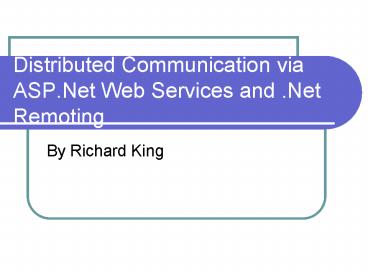Distributed Communication via ASP.Net Web Services and .Net Remoting - PowerPoint PPT Presentation
1 / 14
Title:
Distributed Communication via ASP.Net Web Services and .Net Remoting
Description:
ASP.Net Web Services: provides a simple API (Application Programming Interface) ... This allows for ASP.Net Web Services to work in a heterogeneous environments. ... – PowerPoint PPT presentation
Number of Views:236
Avg rating:3.0/5.0
Title: Distributed Communication via ASP.Net Web Services and .Net Remoting
1
Distributed Communication via ASP.Net Web
Services and .Net Remoting
- By Richard King
2
What are ASP.Net Web Services and .Net Remoting?
- Two new technologies provided in the .Net
Framework for developing distributed
applications. - ASP.Net Web Services and .Net Remoting replace
- Microsofts DCOM (Distributed Component Object
Model) - Java RMI (Remote Machine Invocation)
- CORBA (Common Object Request Broker Architecture)
3
Definitions
- ASP.Net Web Services provides a simple API
(Application Programming Interface) for Web
services based on mapping SOAP (Simple Object
Access Protocol) messages to method invocations.
- .Net Remoting provides an infrastructure for
distributed objects. It exposes the full-object
semantics of .NET to remote processes using
plumbing that is both very flexible and
extensible.
4
.Net Remoting
- A tight coupled client and server approach to
distributed communication. - Supports the communication of a full feature set
of data types. - .Net Remoting has support for passing objects by
value or by reference, callbacks, and
multiple-object activation and lifecycle
management policies. - Similar to Javas RMI.
5
.Net Service Architecture
6
ASP.Net Web Services
- Works by exposing APIs called web methods via
HTTP. - Web Methods provide a service to the end user.
- Enables cross platform integration using XML,
HTTP and SOAP. - Using industry standards makes Web Services
independent of programming languages and
platforms.
7
ASP.Net Web Services Cont
- WSDL (Web Service Discription Language) exposes
web methods, protocols supported, signatures of
methods and web service location. - DISCO (short for discovery) Microsoft technology
for publishing and discovering web services. - UDDI (Universal Description and Discovery
Integration) specification for building
distributed databases that provide parties a way
to discover web services.
8
ASP.Net Web Services and .Net Remoting Compared.
- Protocol
- ASP.Net Web Services only provides access via
HTTP. Data is formatted in a SOAP packets. - .Net Remoting provides access via TCP, HTTP and
custom protocols. Data can be formatted as
binary or SOAP packets.
9
ASP.Net Web Services and .Net Remoting Compared
Cont
- States
- ASP.Net Web Services is a stateless environment.
- .Net Remoting can be a stateful and stateless
environment. - Client Activation
- Under the control of lease-based lifetime
manager. - Lease-times ensure that the objects are garbage
collected when the lease time expires.
Lease-times are set by extending the
MarshalByRefObject class and implementing the
ILease interface inside of MarshalByRefObject . - Server Activation
- Stateless mode
- SingleCall creates a new instance of the
remoting object for each request. - Stateful mode
- Singleton creates only one instance of an object
that is used for all requests.
10
ASP.Net Web Services and .Net Remoting Compared
Cont
- Interoperability
- ASP.Net Web Services works with industry
standards to provide high levels of
interoperability. This allows for ASP.Net Web
Services to work in a heterogeneous environments. - .Net Remoting supplies a tightly coupled form of
distributed communication. Clients must be
implement with the .Net Framework. The tight
coupling causes .Net Remoting to be implemented
in a homogeneous environment.
11
ASP.Net Web Services and .Net Remoting Compared
ASP.Net Web Services .Net Remoting
Support Protocols HTTP TCP, HTTP and etc
State Management Stateless Stateful and Stateless
Types Supports only types defined in XSD (XML Schema Definition). Supports a full feature set of data types.
Interoperability Cross platform support. Works in heterogeneous environments .Net Remoting requires clients be built using .Net. Works only in a homogeneous environment.
Reliability Reliability is supplied by IIS. IIS can supply reliability but if IIS is not used for Remoting, application must supply plumbing to ensure reliability.
12
ASP.Net Web Services and .Net Remoting within the
.Net Framework
13
Sample ASP.Net Web Service
- using System
- using System.Collections
- using System.ComponentModel
- using System.Data
- using System.Diagnostics
- using System.Web
- using System.Web.Services
- namespace Example
- public class Example System.Web.Services.WebServ
ice - WebMethod
- public String SayHello()
- return "Hello"
14
Future of Distributed Computing and .Net
Framework 2.0
- .Net Remoting will transfer to Indigo Services.
- Indigo services will allow for the transfer of
objects without sharing .Net assemblies.































